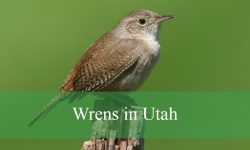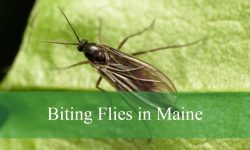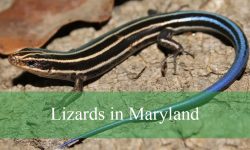Small Birds in Mississippi bring life and color to backyards, parks, and forests throughout the state. Birdwatchers and nature lovers alike enjoy spotting these tiny feathered friends. Mississippi’s variety of habitats provides a perfect home for many small bird species that are both common and easy to identify.
This guide to 37 Small Birds in Mississippi features clear pictures and simple identification tips to help you recognize each species. From lively chickadees to colorful warblers, these small birds brighten the outdoors and can be found throughout the year.
Learning about the most popular Small Birds in Mississippi helps deepen appreciation for the natural world and adds excitement to every outdoor visit. Discover their unique looks, songs, and favorite places to see them in this straightforward guide.
Common Small Birds Found in Mississippi
Carolina Chickadee
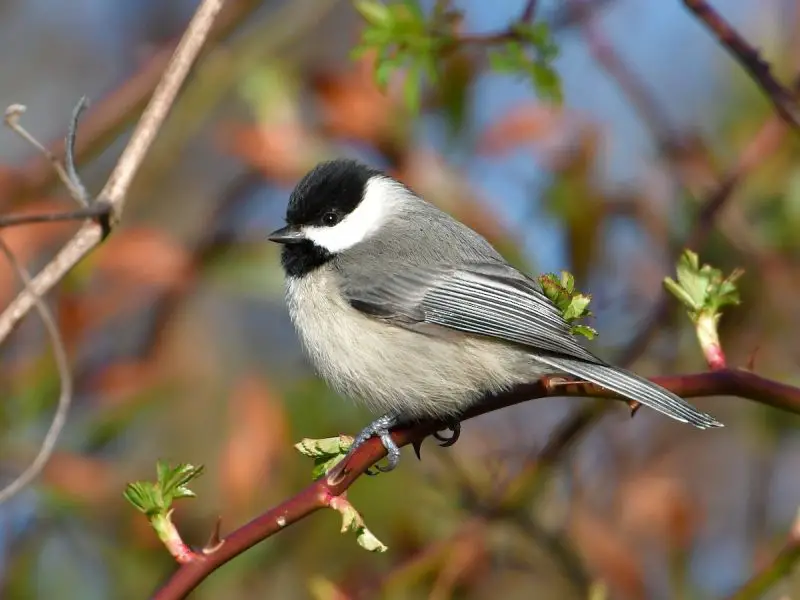
The Carolina Chickadee is a small songbird with soft gray upperparts, a black cap and throat, white cheeks, and pale underparts. It closely resembles the Black-capped Chickadee but is more common in the southeastern U.S., including Mississippi. Adults measure around 4.7 to 5.1 inches long with a wingspan of about 6.3 to 8.3 inches.
These birds are highly active and curious, often seen flitting from branch to branch or hanging upside down while foraging for insects and seeds. They are frequent visitors at backyard feeders, especially those offering sunflower seeds, suet, or peanut bits. Their song is a clear, whistled “fee-bee fee-bay,” and they also emit a distinctive “chick-a-dee-dee” call.
In Mississippi, Carolina Chickadees are widespread and can be found in woodlands, suburban neighborhoods, parks, and wooded backyards. They nest in tree cavities and will readily use nest boxes. This species is a year-round resident throughout the state.
Tufted Titmouse
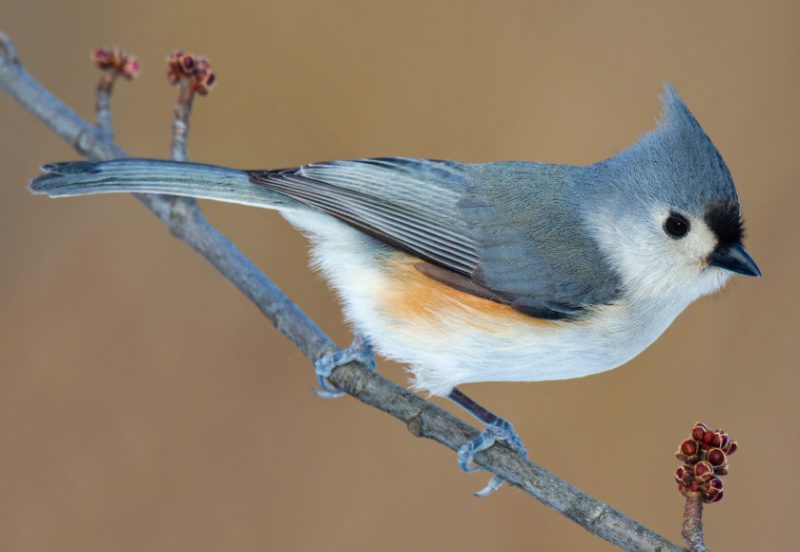
The Tufted Titmouse is a medium-small songbird known for its gray plumage, large black eyes, and distinct gray crest on its head. Its underparts are pale with a subtle peach wash along the flanks. Adults typically measure 5.5 to 6.3 inches in length with a wingspan of about 7.9 to 10.2 inches.
Cheerful and vocal, the Tufted Titmouse often travels in small mixed flocks with chickadees and nuthatches. Its call is a whistled “peter-peter-peter,” easily heard in wooded areas. This bird is agile, often seen hopping through tree branches or clinging to feeders. It favors sunflower seeds, peanuts, and suet.
This species is commonly found throughout Mississippi in deciduous and mixed forests, as well as in urban parks and backyard habitats. It is a year-round resident and frequently nests in natural cavities or birdhouses placed in shaded areas.
White-breasted Nuthatch

The White-breasted Nuthatch is a compact, stocky bird with a large head, short tail, and strong bill. It has blue-gray upperparts, a bright white face and underparts, and a black or gray cap depending on sex. Adults range from 5.1 to 5.5 inches in length, with a wingspan of 7.9 to 10.6 inches.
This bird is famous for its ability to climb down tree trunks headfirst while probing bark crevices for insects. It also eats seeds and will visit feeders for sunflower seeds, peanuts, and suet. Its call is a nasal “yank-yank” often heard as it forages through the trees.
In Mississippi, the White-breasted Nuthatch is a year-round resident found mainly in mature deciduous forests, woodlots, and shaded neighborhoods. It nests in natural cavities or old woodpecker holes and may occasionally use nest boxes in suitable wooded areas.
Carolina Wren
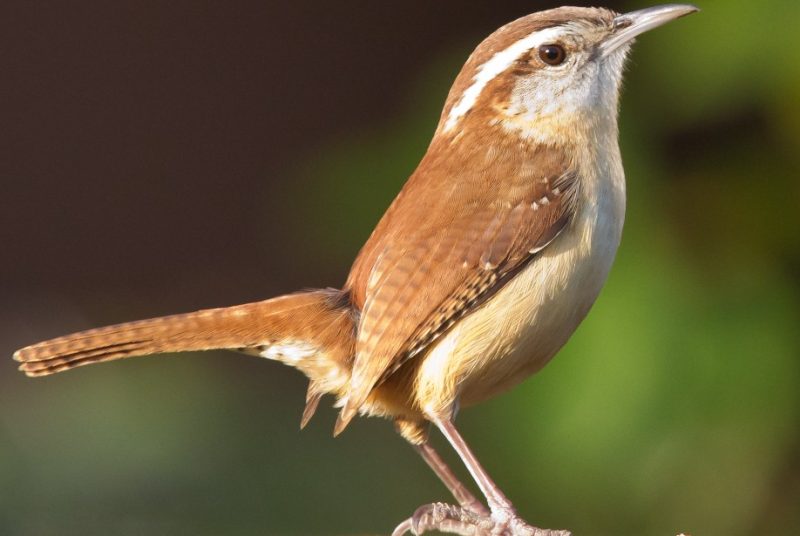
The Carolina Wren is a small, chunky bird with a rich reddish-brown back, a buffy-orange belly, and a long, slightly curved bill. One of its most distinctive features is the prominent white eyebrow stripe above the eye. Adult size ranges from 4.7 to 5.5 inches in length with a wingspan of about 11 inches.
Known for its loud and varied song, the Carolina Wren belts out phrases like “teakettle-teakettle” from concealed perches. These wrens are active and bold, often scurrying through dense underbrush or investigating nooks and crannies for spiders, insects, and small fruits. They readily visit suet feeders in colder months.
Widespread across Mississippi, Carolina Wrens are common in gardens, wooded backyards, brushy edges, and urban areas. They are permanent residents and often nest in hanging flower pots, mailboxes, or other sheltered spots near homes.
House Wren
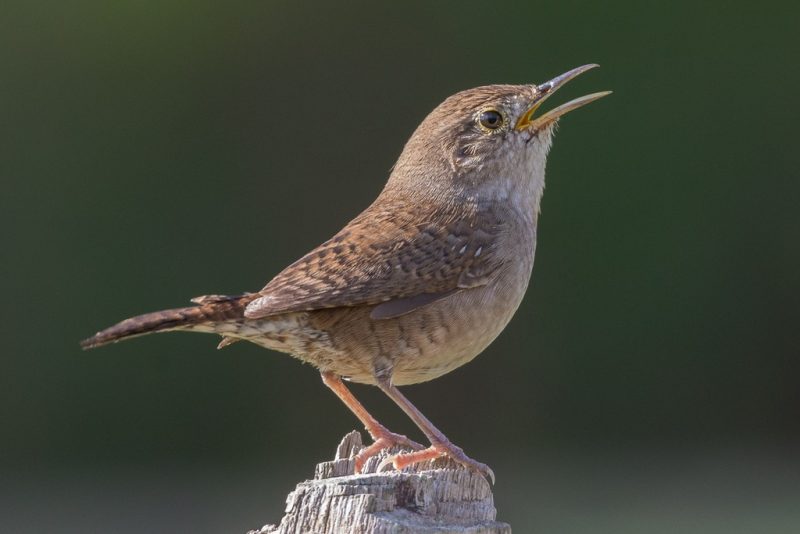
The House Wren is a tiny, energetic bird with brown upperparts, a lighter grayish belly, and faint barring on the wings and tail. It has a slender, curved bill and an upright tail often held cocked. Adults typically measure 4.3 to 5.1 inches long with a wingspan of 5.9 to 6.7 inches.
These wrens are known for their bubbly, complex songs and their restless nature. Males are particularly vocal during the breeding season and will sing persistently from shrubs and fences. House Wrens are cavity nesters and readily use birdhouses, nesting boxes, or natural crevices.
In Mississippi, House Wrens are typically seen during the warmer months, as they migrate southward for the winter. They are common in suburban areas, gardens, and woodland edges, where they find insects and spiders in thick vegetation and man-made structures.
Winter Wren

The Winter Wren is a tiny, compact bird with a short tail often held upright, dark brown plumage, and fine black barring throughout its body. Its short, stubby wings and pale eyebrow stripe help with identification. Adults measure only about 3.1 to 4.3 inches long, making it one of the smallest wrens in North America.
Secretive by nature, this wren prefers dense, tangled vegetation near forest floors, especially around fallen logs, brush piles, or damp ravines. It flits low to the ground, often giving a quick burst of movement and disappearing into cover. Despite its size, the Winter Wren has a surprisingly loud and bubbly song that can carry well through woodlands.
In Mississippi, the Winter Wren is a seasonal visitor, primarily seen in the colder months. It migrates from northern breeding grounds and spends winter in moist, wooded areas across the state. Observers often find it near creeks, swamps, and thickets, especially in protected forests and nature preserves.
Sedge Wren
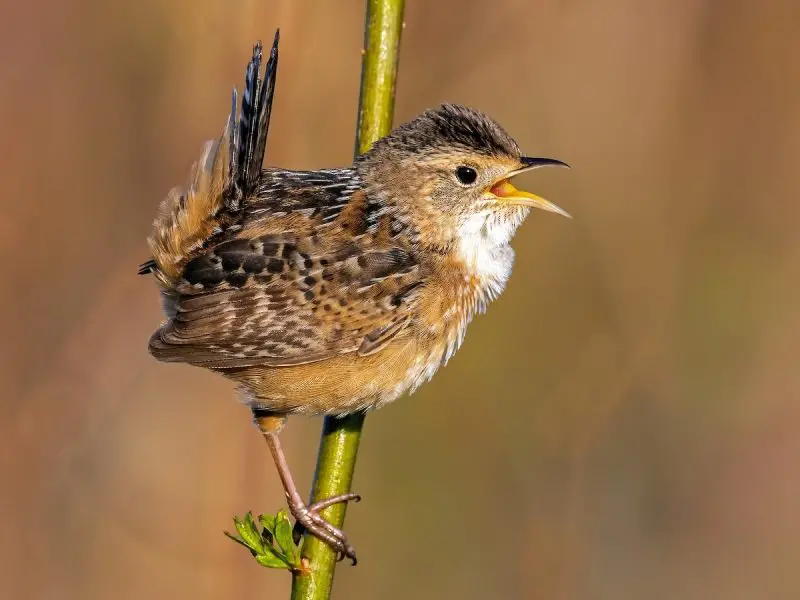
The Sedge Wren is a small, elusive songbird with buffy underparts, brown streaked upperparts, and a finely barred tail. It has a short bill and a pale eyebrow stripe, which helps distinguish it from other wrens. Adult size typically ranges from 4.3 to 5.1 inches in length.
This wren prefers tall grasses and sedges in open meadows, fields, and wet prairies. Unlike the more vocal Marsh Wren, the Sedge Wren sings short, dry trills and is often quiet or difficult to locate. It is a ground-nester and usually stays low in vegetation, moving with quick hops and flicks of its wings and tail.
In Mississippi, the Sedge Wren is considered an uncommon and somewhat irregular breeder or migrant. It is most often detected in moist grasslands or agricultural fields with thick grassy cover. Some individuals may overwinter in southern portions of the state if conditions are suitable.
Marsh Wren
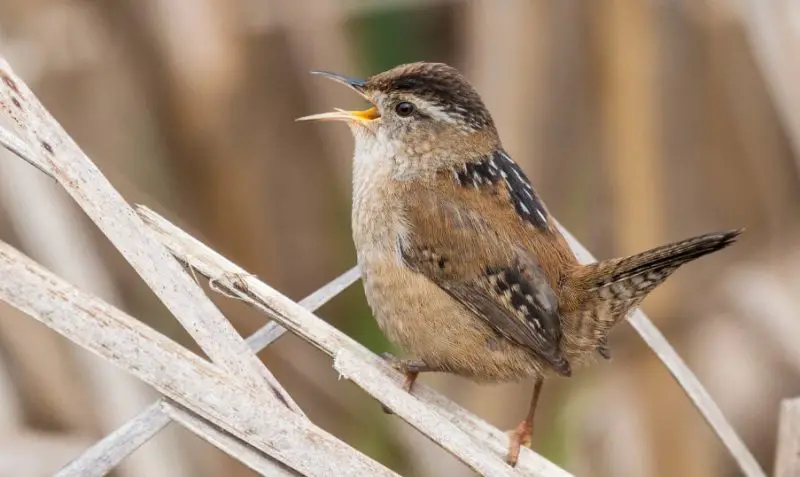
The Marsh Wren is a small, lively bird with brown upperparts, a white or buffy underside, and a distinct white eyebrow. Its back is streaked with black and white, and its short, upright tail is often flicked while it moves through reeds. Adults typically measure 4.3 to 5.1 inches long.
As its name suggests, the Marsh Wren is strongly associated with wetlands, especially cattail marshes and reed beds. It sings a fast, mechanical trill, often repeated throughout the day and night. Marsh Wrens are territorial and will aggressively defend their nesting area, which is typically a ball-shaped nest woven into reeds.
In Mississippi, Marsh Wrens are considered fairly localized and uncommon. They are mostly found in freshwater marshes, especially during migration or in areas with extensive wetland vegetation. A few may remain in the southern part of the state during winter, but most are transient visitors.
Rock Wren
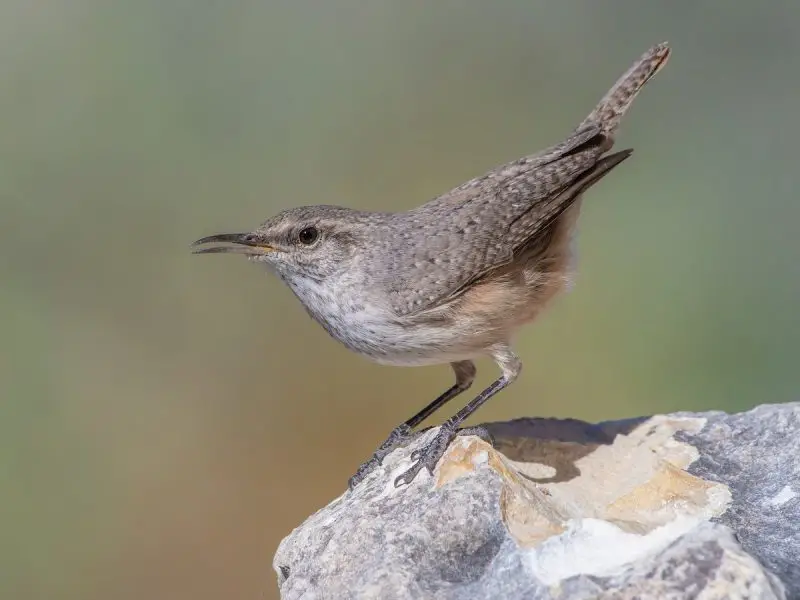
The Rock Wren is a pale, slender wren with light gray and brown plumage, a faintly speckled breast, and a slightly curved bill. It has a noticeably long, bobbing tail and pale buff tones on its underparts. Adults are typically 5.5 to 6.3 inches in length.
This bird is typically found in rocky, arid environments such as cliffs, canyons, and boulder-strewn slopes. It walks or hops among rocks while foraging for insects, often pausing to bob its body in a rhythmic motion. Its song is a mixture of sweet, high-pitched phrases and trills, often delivered from an elevated perch.
In Mississippi, the Rock Wren is considered an accidental or very rare visitor. It occasionally appears in the state during migration or after being blown off course but does not breed or winter regularly in the region. Most sightings occur in rocky or open fields with scattered stones or debris.
Chipping Sparrow

The Chipping Sparrow is a small, slender sparrow with a clean gray underside, streak-free chest, and a bright rusty cap during the breeding season. It has a thin black eye-line and a pale eyebrow. In nonbreeding plumage, its colors are more muted but still recognizable. Adults are about 4.7 to 5.9 inches in length.
This sparrow is known for its high, dry trill, often heard from treetops or fences. It forages mostly on the ground for seeds and insects and will readily visit feeders for mixed seed blends. Chipping Sparrows are social, sometimes forming flocks with other sparrows in winter months.
In Mississippi, Chipping Sparrows are common across the state, especially during migration and winter. They inhabit open woodlands, grassy lawns, and suburban areas with scattered trees. During the breeding season, they are more commonly found in pine forests or lightly wooded areas.
Dark-eyed Junco
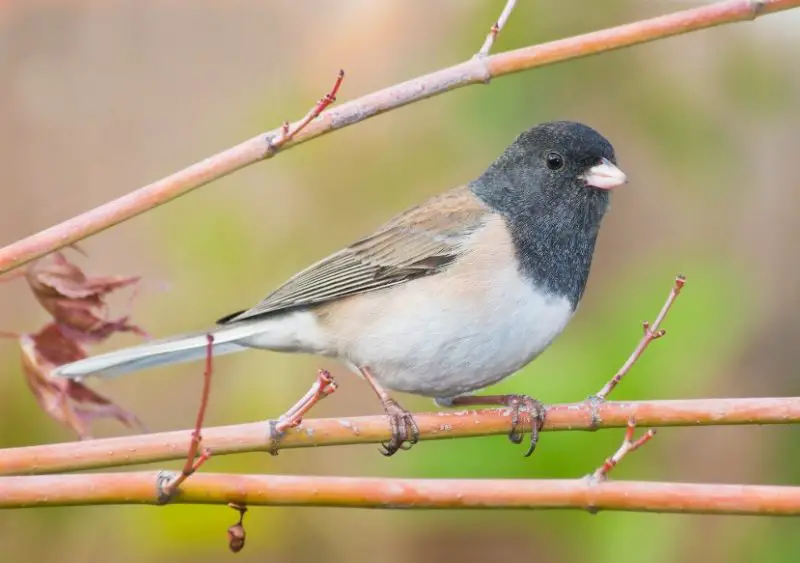
The Dark-eyed Junco is a small sparrow with a smooth slate-gray body and crisp white belly. It has a rounded head, pinkish bill, and a long tail with noticeable white outer feathers that flash in flight. Adults typically measure 5.1 to 6.9 inches long with a wingspan of 7.1 to 9.8 inches.
These juncos are ground-feeding birds that prefer open areas under shrubs or near the base of trees. They often hop rather than walk and are easily recognized by their flashing tail feathers and busy movements. At feeders, they favor millet and cracked corn scattered on the ground.
In Mississippi, Dark-eyed Juncos are common winter visitors, especially from late fall through early spring. They breed farther north in the U.S. and Canada but migrate southward during colder months. You’ll often find them in open woodlands, suburban yards, and forest edges across the state.
White-throated Sparrow
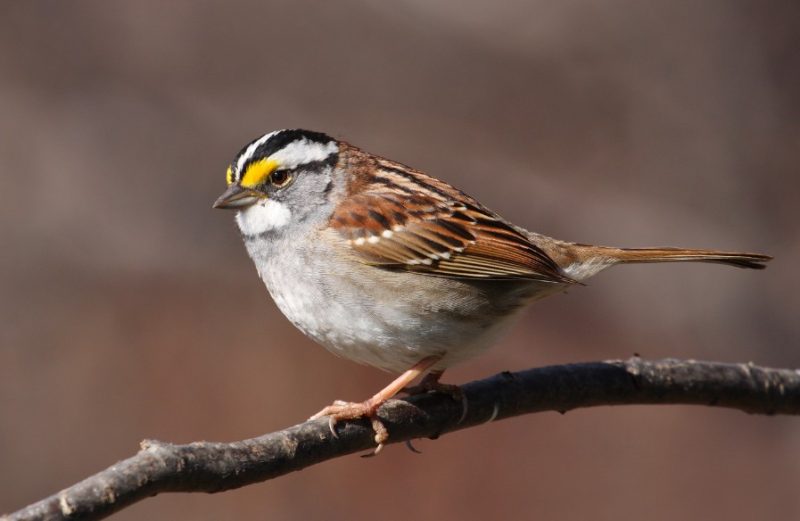
The White-throated Sparrow is a medium-sized songbird with a striking black-and-white striped head and a bright white throat bordered by yellow spots in front of the eyes. Its body is mostly brown with streaked sides and a grayish breast. Adults range from 6.3 to 7.1 inches long.
This sparrow is often seen foraging in leaf litter, kicking aside debris with both feet to uncover seeds and insects. Its clear, whistled song sounds like “Oh-sweet-Canada-Canada” and can be heard even in winter. Though not a constant feeder bird, it may visit yards offering millet or mixed seed blends.
In Mississippi, White-throated Sparrows are common during the nonbreeding season. They arrive in the fall and stay through early spring, typically found in thickets, brush piles, woodland edges, and backyard gardens. Their presence at feeders increases during colder weather.
American Goldfinch
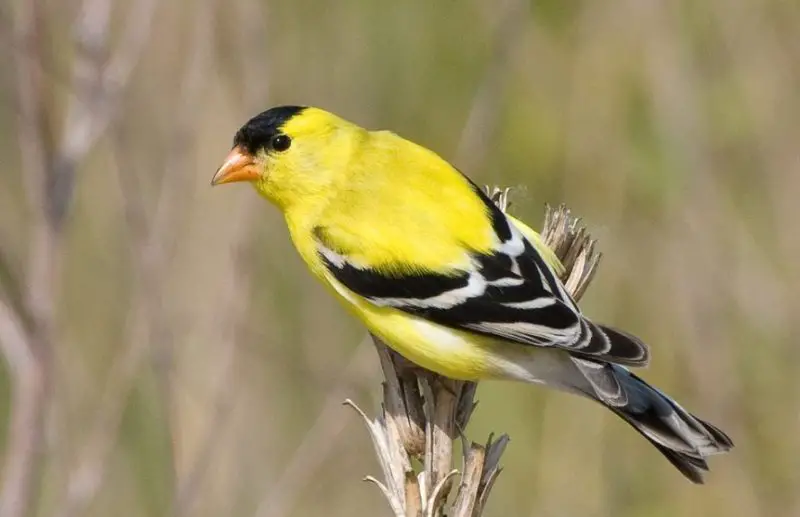
The American Goldfinch is a small, vibrant finch best known for its bright lemon-yellow plumage in breeding males, contrasted by black wings and cap. Females and winter birds are duller, with olive or brownish tones. Adults are about 4.3 to 5.1 inches long, with a wingspan around 7.5 to 8.7 inches.
This bird has an undulating flight pattern and a cheerful, twittering song. It is especially fond of nyjer (thistle) seed and can often be found clinging to specialized feeders. American Goldfinches are late nesters, breeding in midsummer when thistle plants are in full seed.
In Mississippi, goldfinches are seen year-round, though they are more numerous during the fall and winter. In warm months, they inhabit weedy fields and open woodland edges. During the colder seasons, they flock to feeders and are commonly seen in suburban yards and parks.
Pine Siskin
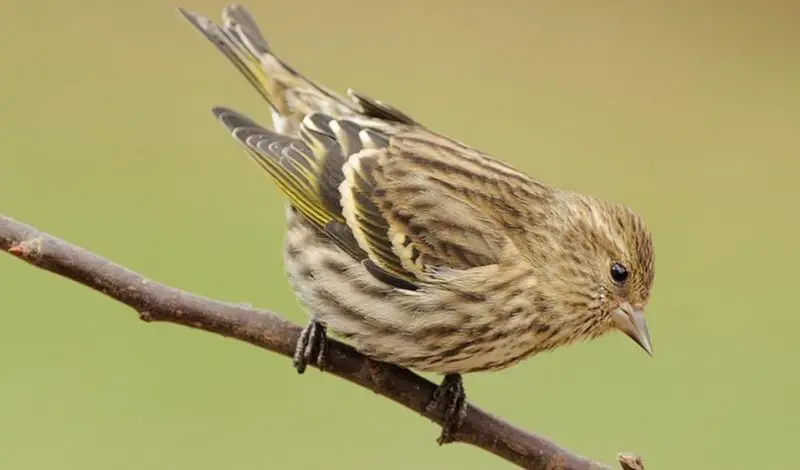
The Pine Siskin is a small, slender finch with heavily streaked brown plumage and subtle yellow patches on the wings and tail. It has a thin, pointed bill and a slightly notched tail. Adults measure about 4.3 to 5.5 inches long and weigh under half an ounce.
These birds are energetic and acrobatic, often feeding while hanging upside down from branch tips or feeder ports. They favor nyjer and sunflower seeds and may arrive in large numbers during irruption years, when their northern food sources are scarce. Their call is a buzzy, rising “zreee.”
Pine Siskins are irregular winter visitors in Mississippi. While some years bring only a few scattered individuals, other winters may see flocks descending on feeders across the state. They are typically found in coniferous edges, suburban areas, and mixed forests during their stay.
Purple Finch
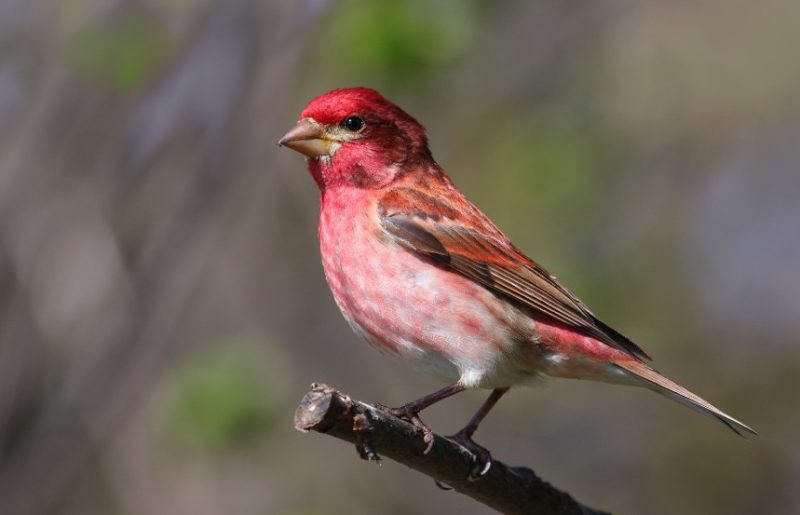
The Purple Finch is a chunky finch with a thick bill and notched tail. Males have a raspberry-red wash over the head, chest, and back, while females are brown and heavily streaked, with a bold white eyebrow. Adults are typically 4.7 to 6.3 inches in length.
These finches prefer seeds, especially sunflower and thistle, and will also consume berries and buds. They have a rich, warbling song and a soft “pik” call. Though they can resemble House Finches, Purple Finches have a more saturated, wine-colored appearance and lack the brown streaking on the flanks in males.
In Mississippi, Purple Finches are less common than some other finch species and are usually seen during winter. They favor wooded areas, forest edges, and well-stocked feeders in rural or suburban gardens. Their numbers may fluctuate from year to year depending on food availability up north.
Eastern Bluebird
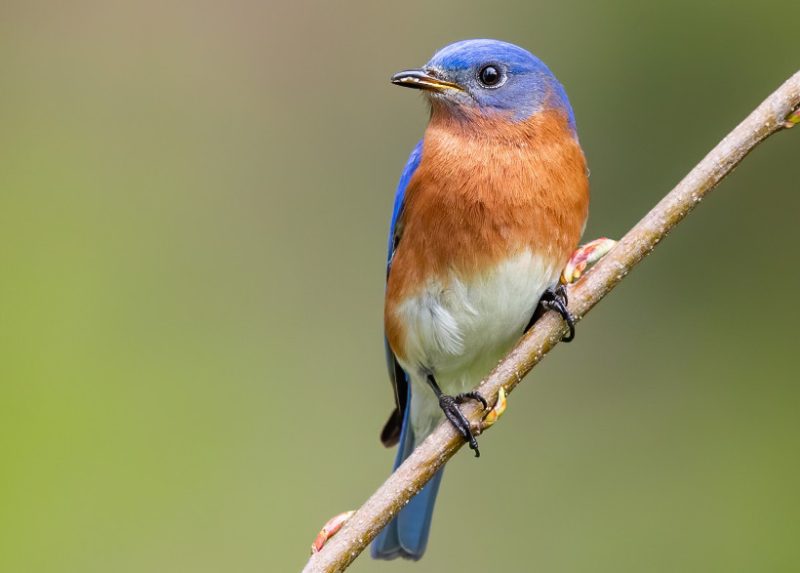
The Eastern Bluebird is a striking songbird with vivid blue plumage on its back and wings, a rusty orange chest, and a white belly. Females are duller with grayish tones, but still show blue highlights on their wings and tail. Adults typically measure 6.3 to 8.3 inches in length and have a wingspan of about 9.8 to 12.6 inches.
This bird is often seen perched on fences, wires, or low branches while scanning the ground for insects. It feeds on beetles, grasshoppers, caterpillars, and berries, and will occasionally visit feeders for mealworms or fruit. Eastern Bluebirds have a soft, musical warble and are known for their gentle temperament.
In Mississippi, Eastern Bluebirds are widespread and commonly seen in open areas with scattered trees, such as pastures, parks, golf courses, and suburban lawns. They are year-round residents and nest readily in bluebird boxes placed in suitable, open spaces with little underbrush.
House Finch
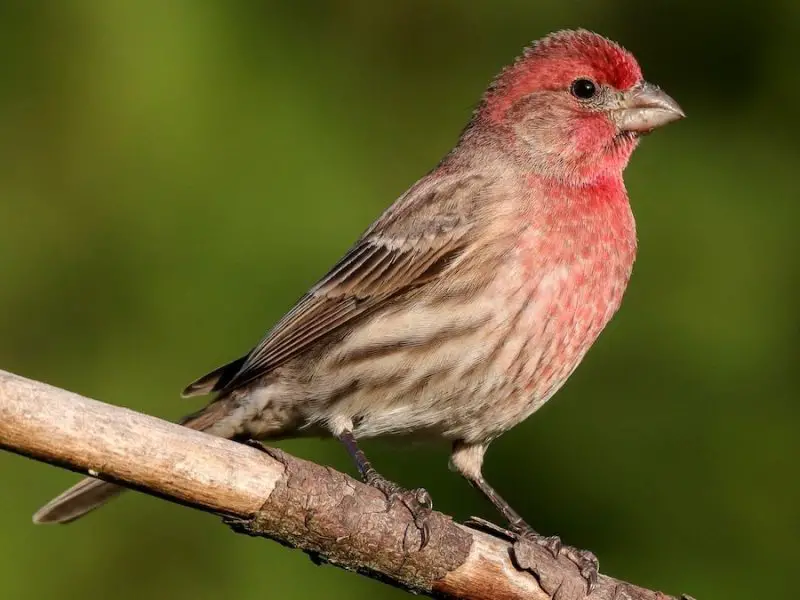
The House Finch is a small, stocky finch with streaky brown plumage and a slightly curved bill. Males are distinguished by their rosy-red forehead, chest, and rump, while females are more uniformly brown and streaked. They typically measure 5.1 to 5.5 inches in length with a wingspan of around 7.9 to 9.8 inches.
These finches are very social and often appear in flocks, especially near backyard feeders. They sing a rich, warbling song composed of short notes and trills. House Finches thrive in urban and suburban settings and are commonly seen on feeders offering sunflower seeds and other mixed seed blends.
In Mississippi, House Finches are well-established and can be found throughout the year. They favor residential areas, farms, and city parks, often nesting in hanging planters, eaves, and vents. Their adaptability makes them one of the most familiar feeder birds in the state.
Northern Cardinal
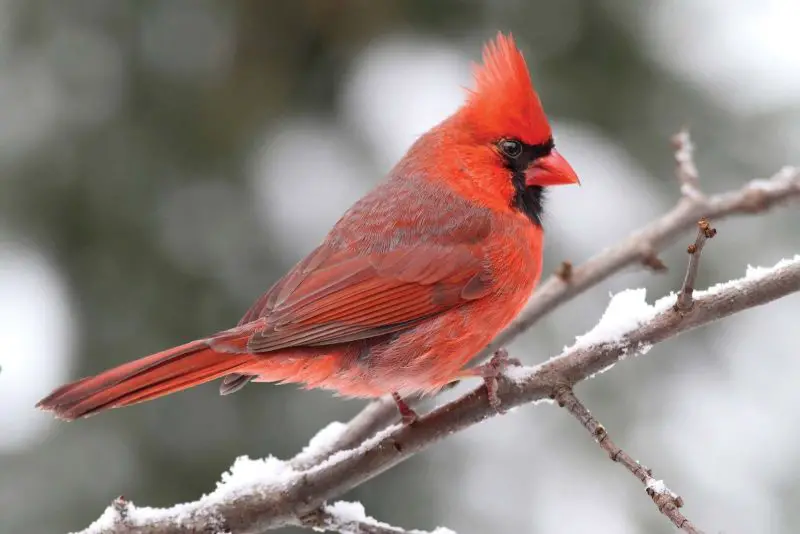
The Northern Cardinal is a medium-sized songbird well known for its brilliant red plumage in males and soft brownish tones with red accents in females. Both sexes have a prominent crest, a black face mask, and a stout orange-red bill. Adults are about 8.3 to 9.1 inches long with a wingspan of 9.8 to 12.2 inches.
These cardinals are strong songbirds, with a variety of clear, whistling notes used to claim territory or communicate with mates. They are frequent feeder visitors, especially fond of sunflower seeds, safflower, and peanuts. Cardinals are also known for their early morning singing, even in winter.
Throughout Mississippi, the Northern Cardinal is a familiar sight in woodlands, gardens, and neighborhoods. It is a permanent resident of the state and nests in shrubs, small trees, and thickets. Its year-round presence and vivid coloration make it one of the most recognizable birds in the region.
Blue Jay

The Blue Jay is a bold and intelligent bird with striking blue plumage, a prominent crest, black necklace, and white underparts. Its wings and tail are barred with white and black, and it has a sturdy, black bill. Adults measure about 9.8 to 11.8 inches in length with a wingspan of 13.4 to 16.9 inches.
These jays are known for their loud calls, mimicry of hawks, and assertive behavior. They are frequent visitors to feeders, especially enjoying peanuts, sunflower seeds, and suet. Blue Jays often cache food to eat later and may dominate other birds at feeding stations.
In Mississippi, Blue Jays are common year-round in forests, parks, and residential areas with mature trees. They are especially active in fall and winter, gathering in loose flocks and often alerting other birds to predators with their sharp “jay-jay” call.
Mourning Dove
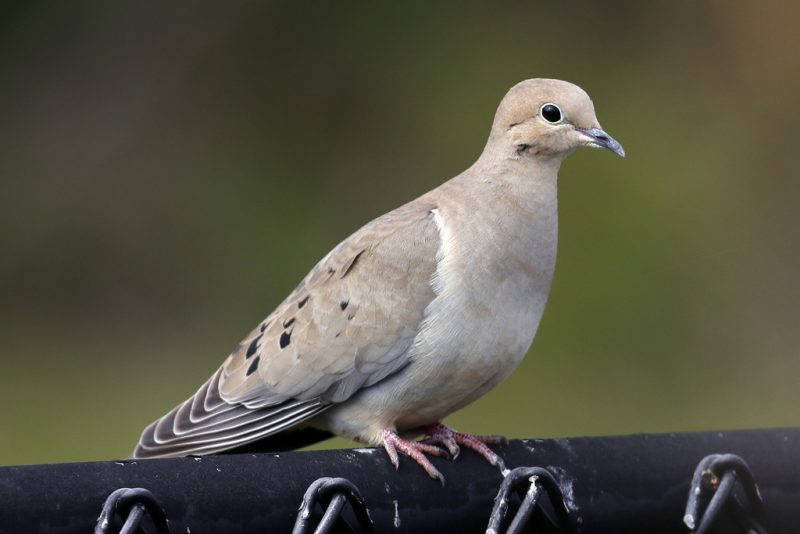
The Mourning Dove is a slender, medium-sized dove with a small head, soft grayish-tan plumage, and black spots on the wings. It has a long, pointed tail edged with white and a gentle expression. Adults range from 9.1 to 13.4 inches long, with a wingspan of 17.7 inches.
This species feeds primarily on seeds and prefers to forage on the ground beneath feeders or in open fields. Its mournful, cooing call is a familiar background sound across Mississippi landscapes. Mourning Doves are fast fliers and often flush with loud wingbeats when startled.
Mourning Doves are one of the most widespread birds in Mississippi and can be found in both rural and urban settings. They are year-round residents that nest in trees, shrubs, or even on flat surfaces like balconies or gutters. Their peaceful demeanor and frequent feeder visits make them popular with birdwatchers.
Northern Mockingbird
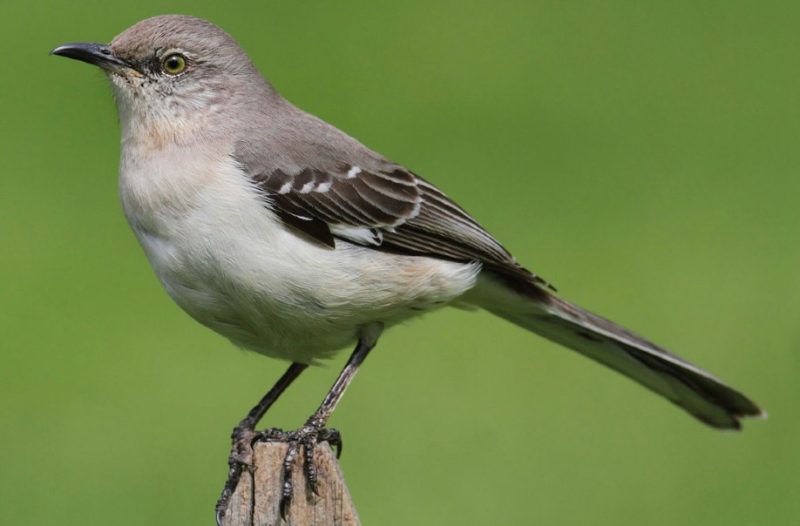
The Northern Mockingbird is a medium-sized songbird with smooth gray upperparts, a pale belly, and bold white patches on the wings and tail that flash during flight. It has a slender, curved bill and a long tail that it often flicks downward. Adults measure about 8.3 to 10.2 inches long with a wingspan of 12 to 14 inches.
Famous for its vocal talents, the Northern Mockingbird mimics the songs and calls of other birds, often repeating phrases multiple times in a row. Males sing from high perches during the day and even at night, especially in spring. Mockingbirds are territorial and may dive at perceived intruders near nests.
In Mississippi, this bird is one of the most common backyard species and can be found year-round across the state. It thrives in urban areas, gardens, open fields, and forest edges. Its bold behavior and melodic song make it a familiar presence in neighborhoods and parks.
Brown Thrasher
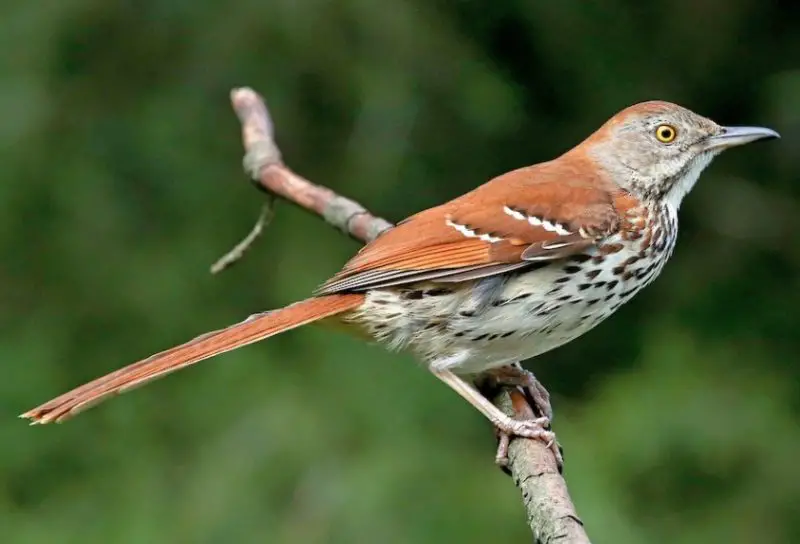
The Brown Thrasher is a large, long-tailed songbird with rich reddish-brown upperparts, heavily streaked underparts, and a bright yellow eye. It has a strong, slightly curved bill and pale wing bars. Adults typically measure 9.1 to 11.8 inches long with a wingspan of 11.4 to 12.6 inches.
A gifted songster, the Brown Thrasher has a vast repertoire of musical phrases, often repeating each note or phrase twice. It spends much of its time foraging on the ground in leaf litter, using its bill to sweep aside debris in search of insects, seeds, and berries. Though shy, it will occasionally visit feeders with fruit or suet.
Brown Thrashers are widespread throughout Mississippi, especially in brushy woodlands, suburban yards, and hedgerows. They are most noticeable in spring and summer during nesting season but remain in many parts of the state year-round. Dense shrubbery provides ideal nesting cover and feeding grounds.
Yellow-rumped Warbler
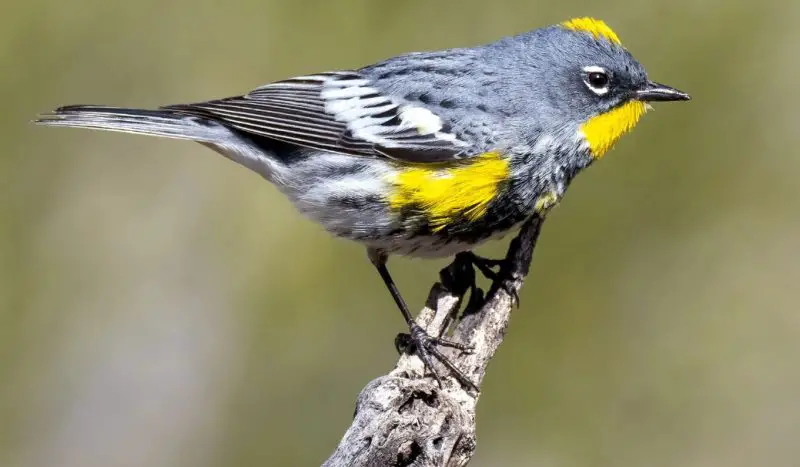
The Yellow-rumped Warbler is a small, active bird with gray and white plumage, a bright yellow patch on the rump, and additional yellow markings on the sides and crown. In winter, its colors are more subdued but still show the distinctive yellow rump. Adults range from 4.7 to 5.9 inches in length.
During cooler months, this warbler is one of the few in its family that remains in Mississippi, thanks to its ability to digest waxy berries like those of bayberry and wax myrtle. It is often seen flitting through trees or hovering briefly to pick insects off leaves. At feeders, it may visit suet or fruit offerings.
In Mississippi, Yellow-rumped Warblers are common winter residents, especially in wooded areas, parks, and backyards. Their numbers increase in fall and remain high through early spring. They are among the most visible warblers in the state during the colder seasons.
Golden-crowned Kinglet

The Golden-crowned Kinglet is a tiny, fast-moving bird with olive-gray plumage, pale underparts, and a distinctive yellow crown bordered by black stripes. Males also show an orange center in the crown. Adults measure only 3.1 to 4.3 inches in length, with a wingspan of about 5.5 to 7.1 inches.
Kinglets are extremely energetic, often seen flitting rapidly through conifer branches or hovering briefly while gleaning insects from foliage. They frequently flick their wings and emit a series of high-pitched “tsee” notes. Though they are small, they are surprisingly hardy and tolerate cold temperatures well.
In Mississippi, Golden-crowned Kinglets are winter visitors and are most often found in mixed forests, especially with pines or cedars. They may join mixed-species flocks and occasionally visit suet feeders. Their small size and quick movements make them a delightful challenge to spot.
Blue-gray Gnatcatcher
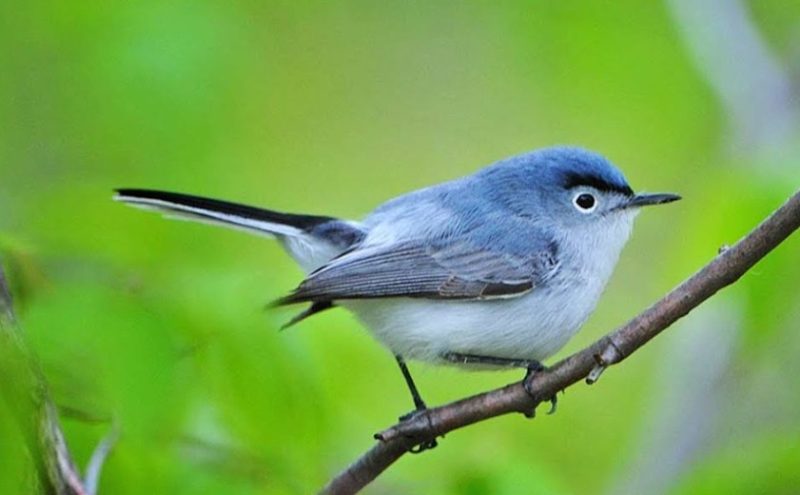
The Blue-gray Gnatcatcher is a petite, slender songbird with soft blue-gray plumage, a long black tail with white edges, and a thin, pointed bill. It has a pale eye ring and a slightly fussy appearance due to its constant motion. Adults typically measure 4.3 to 4.7 inches long with a wingspan of about 6.3 inches.
This bird is highly active, fluttering through foliage in search of small insects and spiders. It often flicks its tail from side to side and emits a sharp, nasal “spee” or “zheee” call. It builds a delicate cup-shaped nest out of lichens and plant fibers, usually high in trees.
In Mississippi, Blue-gray Gnatcatchers are summer residents, arriving in spring to breed in woodlands, thickets, and suburban areas. They are particularly common near streams, forest edges, and shrubby habitats. Their animated foraging behavior and soft vocalizations make them easy to detect once familiar.
Brown Creeper

The Brown Creeper is a small, tree-climbing bird with cryptic brown and white-streaked plumage that helps it blend into bark. Its long, downcurved bill and stiff tail feathers aid in its unique foraging style. Adults are about 4.7 to 5.5 inches long, with a wingspan of roughly 6.7 to 7.9 inches.
This bird typically spirals up tree trunks as it searches for insects, eggs, and larvae hiding in bark crevices. Once it reaches the top, it flutters to the base of another tree and starts again. Its high-pitched, thin call is often the first sign of its presence, though it may go unnoticed due to its camouflaged appearance.
In Mississippi, the Brown Creeper is primarily a winter visitor, especially in mature forests and wooded parks. It favors large trees with loose bark or rough surfaces. Though secretive, it may join mixed winter flocks and occasionally shows up in suburban wooded areas during cold months.
Nashville Warbler
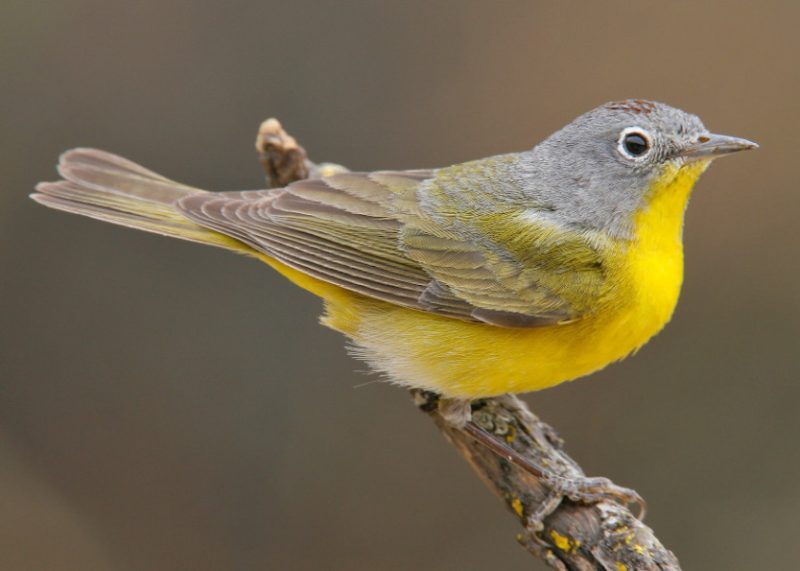
The Nashville Warbler is a small, active warbler with a gray head, bright yellow throat and belly, and olive-green back. It also shows a faint white eye ring and sometimes a hidden rusty crown patch. Adults typically measure 4.3 to 5.1 inches long, with a wingspan of around 6.7 inches.
This bird is constantly in motion, flitting through shrubs and tree branches in search of caterpillars and other insects. Its song is a series of sharp, accelerating notes followed by a trill, often heard during migration. Though less flashy than some warblers, its clean coloration and behavior make it distinct.
In Mississippi, the Nashville Warbler is seen mostly during spring and fall migration. It passes through forested areas, gardens, and low thickets, pausing to feed and rest. It does not breed in the state but is a regular transient that may briefly appear at water features or shady yards during its journey.
Downy Woodpecker
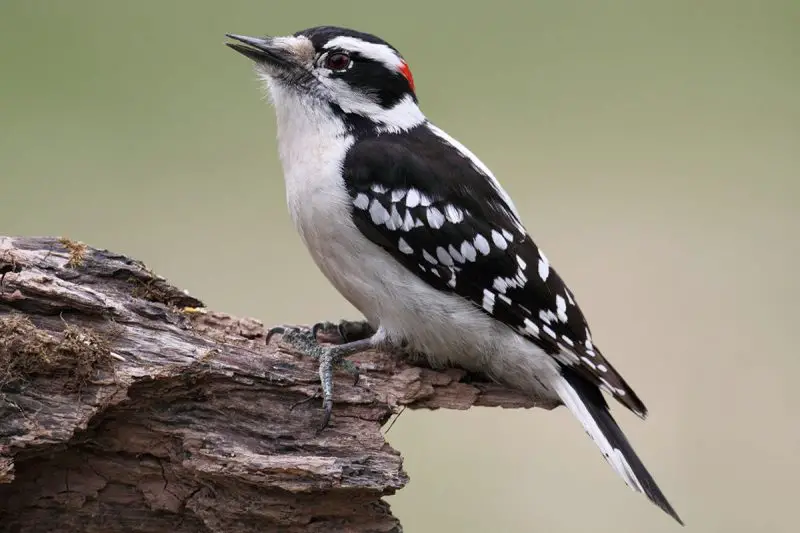
The Downy Woodpecker is the smallest woodpecker in North America, with a compact body, black-and-white plumage, and a short, chisel-like bill. Males have a small red patch on the back of the head, while females lack this marking. Adults measure 5.5 to 6.7 inches long with a wingspan of about 9.8 to 11.8 inches.
These birds are commonly seen clinging to tree trunks or hanging from slender branches as they search for insects, larvae, and suet. They often give a sharp “pik” call and emit a short, whinnying trill. Downy Woodpeckers are active year-round and adapt well to human-dominated landscapes.
In Mississippi, they are frequent visitors to backyard feeders, especially those offering suet, peanuts, or sunflower seeds. Found in forests, woodlots, suburban yards, and parks, they are one of the most familiar and widespread woodpeckers in the state.
Hairy Woodpecker
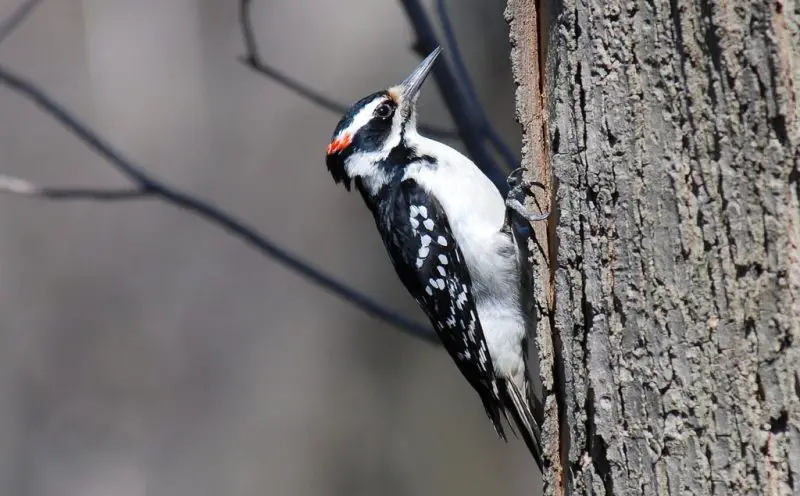
The Hairy Woodpecker looks nearly identical to the Downy but is noticeably larger and has a longer, more robust bill. Its plumage features bold black-and-white contrast with a white back and outer tail feathers that are plain white, unlike the spotted pattern in Downy. Adults typically measure 7.1 to 10.2 inches long.
This woodpecker is a strong, deliberate driller and often taps loudly on tree trunks as it forages for beetles, ants, and larvae beneath the bark. Its call is a sharp “peek” or a high-pitched rattle. While less common around people than Downy Woodpeckers, they still visit feeders in well-wooded yards.
In Mississippi, Hairy Woodpeckers are year-round residents found in mature woodlands, swampy forests, and wooded suburbs. They prefer larger trees and deeper woods but may come to feeders in rural or forested areas for suet and seeds.
Northern Flicker
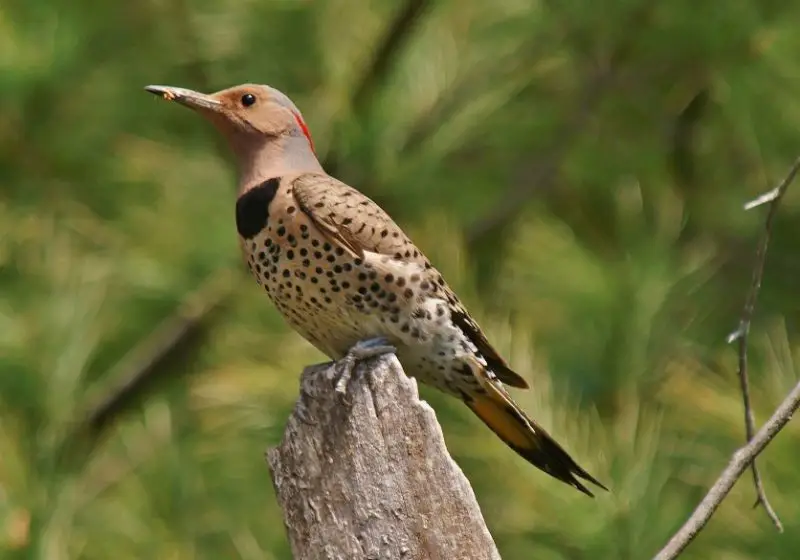
The Northern Flicker is a large woodpecker with warm brown plumage, black bars on the back, and a white rump visible in flight. Eastern birds in Mississippi belong to the “Yellow-shafted” form, showing yellow under the wings and tail, a black bib, and a red patch on the nape. Adults measure 11 to 12.2 inches long.
Unlike other woodpeckers, Northern Flickers often feed on the ground, using their slightly curved bills to dig for ants and beetles. Their loud “wick-a-wick-a-wick” call and distinctive, bouncing flight help identify them from a distance. They may also drum on trees or metal objects during breeding season.
In Mississippi, Northern Flickers are common year-round but are especially visible during migration. They frequent forest edges, open woodlands, yards, and golf courses, and will occasionally visit ground feeders for seeds or scattered mealworms.
Cedar Waxwing

The Cedar Waxwing is a sleek, elegant songbird with silky tan and gray plumage, a pale yellow belly, a black mask, and bright red wax-like tips on its wing feathers. The tail is tipped in yellow, and some birds show orange or reddish variations depending on diet. Adults measure 5.5 to 6.7 inches long.
These birds are known for their flocking behavior and preference for fruit, often feeding in coordinated groups on berries and small fruits. Their call is a soft, high-pitched trill or whispery hiss. Cedar Waxwings are social and gentle, sometimes even passing food to one another.
In Mississippi, they are found mainly in winter and early spring, although a few may nest in the northern part of the state. They appear in orchards, wooded suburbs, and near fruit-bearing trees and shrubs like dogwood, cedar, holly, and serviceberry.
Indigo Bunting
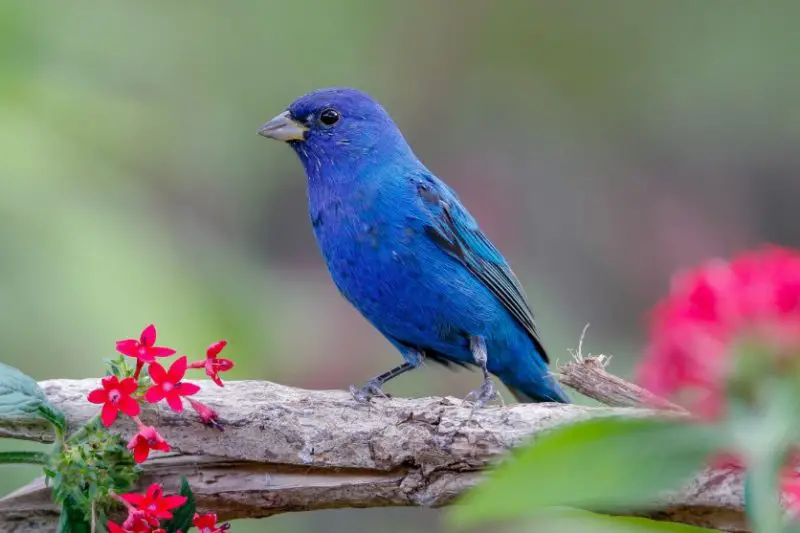
The Indigo Bunting is a small, brilliant songbird with deep blue plumage in breeding males and warm brown tones in females and nonbreeding males. The male appears almost iridescent in sunlight, while females show faint streaks and subtle facial markings. Adults measure about 4.7 to 5.1 inches long.
This species sings persistently from tall weeds or tree tops, producing a cheerful, bouncy warble. It forages for seeds and insects and can be seen hopping through low vegetation or fluttering around feeders. Though not aggressive, males are territorial during the nesting season.
In Mississippi, Indigo Buntings are common summer residents, arriving in spring and staying through early fall. They are frequently seen along forest edges, overgrown fields, and rural backyards, particularly where native plants and low brush provide cover and food.
American Robin
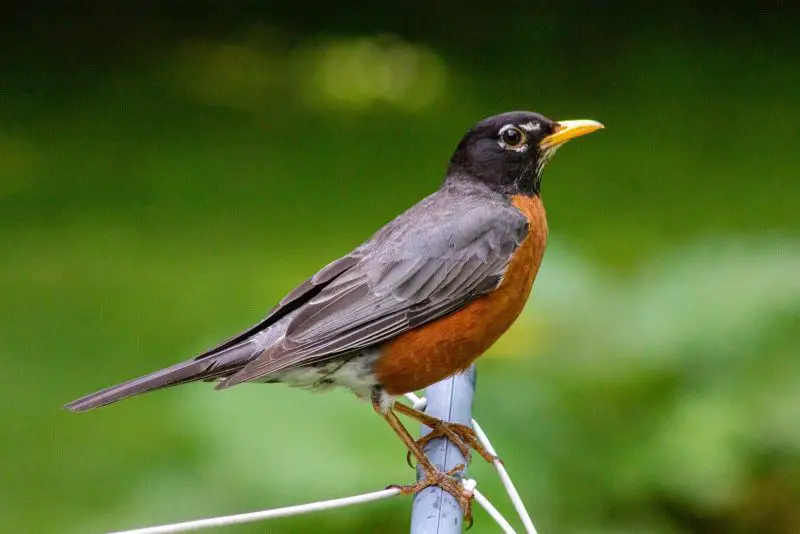
The American Robin is a medium-sized thrush with a warm orange-red breast, grayish-brown upperparts, and a white throat streaked with black spots. It has a yellow bill and a distinctive white eye ring. Adults measure about 9 to 11 inches in length with a wingspan of 12 to 16 inches.
Robins are versatile foragers, often seen hopping on lawns searching for earthworms and insects, especially after rain. They also eat berries and fruits, which makes them common visitors to yards and gardens. Their song is a melodic series of cheerfully whistled phrases, often heard at dawn.
In Mississippi, American Robins are widespread year-round residents and abundant during migration. They frequent open areas, suburban yards, parks, and woodlands, readily adapting to human environments. Their presence is often a sign of changing seasons.
Bank Swallow
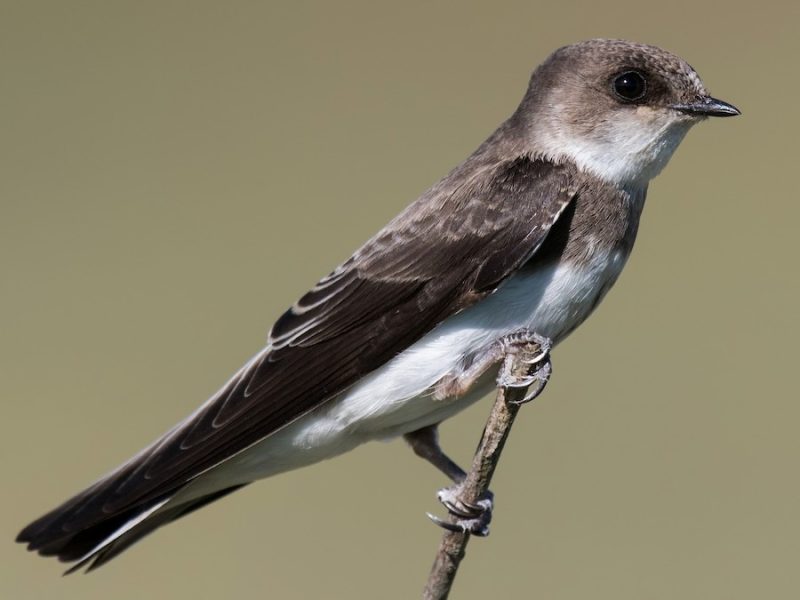
The Bank Swallow is a small, slender aerial insectivore with brown upperparts and white underparts, including a distinct brown band across its chest. Adults measure about 4.7 to 5.5 inches long with a wingspan near 11 inches.
This species nests colonially in vertical sandy banks or cliffs, digging tunnel-like burrows where they raise their young. Bank Swallows catch flying insects on the wing with agile, swift flight, often seen swooping low over water or open fields.
In Mississippi, Bank Swallows are migratory visitors primarily during spring and summer breeding seasons. They nest in suitable sandy riverbanks and are common near water bodies or open landscapes where insect prey is abundant. After breeding, they migrate southward for the winter.
Barn Swallow

The Barn Swallow is a sleek, agile swallow with iridescent blue-black upperparts, a tawny underbelly, and a deeply forked tail with elongated outer feathers. Adults measure roughly 5.5 to 7 inches long, with a wingspan of 11 to 13 inches.
Known for their graceful, acrobatic flight, Barn Swallows catch insects midair and often nest in barns, bridges, or other man-made structures. Their loud, gurgling calls and twittering songs are common in rural and suburban areas throughout the warmer months.
In Mississippi, Barn Swallows are common migrants and summer residents. They arrive in spring to breed and are widely seen over open fields, farms, and water bodies. They frequently return to the same nesting sites year after year before migrating south in fall.
Ruby-crowned Kinglet
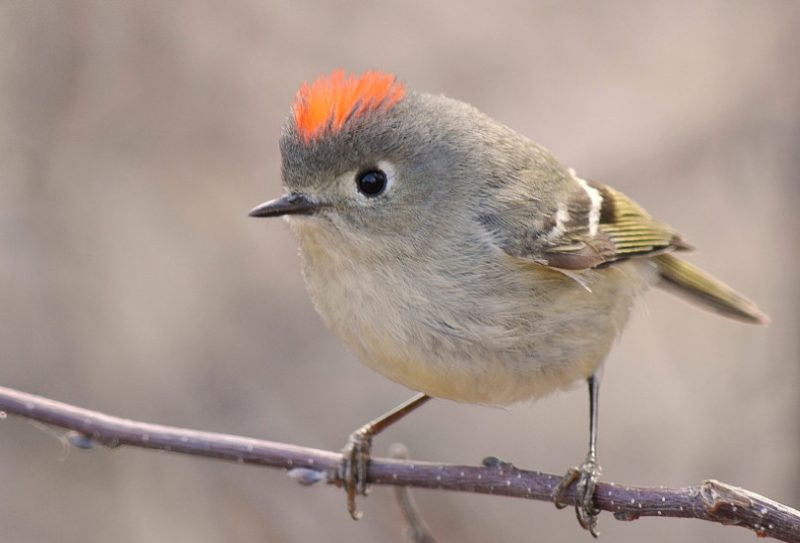
The Ruby-crowned Kinglet is a very small, agile songbird with olive-green plumage and a distinctive bright red crown patch that is usually visible only in males. Despite its tiny size, measuring around 3.1 to 4.3 inches long, it is remarkably active, flitting quickly through branches and foliage.
This species commonly appears in Mississippi during the winter months, favoring mixed woodlands, parks, and dense shrubbery. It feeds primarily on small insects and spiders, gleaning them from leaves and bark. Its high-pitched, short call is sharp and easily recognizable to experienced birders.
Ruby-crowned Kinglets often join mixed-species flocks in winter, moving constantly in search of food. Their restless behavior and distinctive crown patch make them a favorite among birdwatchers, especially during colder seasons when they brighten the otherwise quiet forests.
Eastern Phoebe
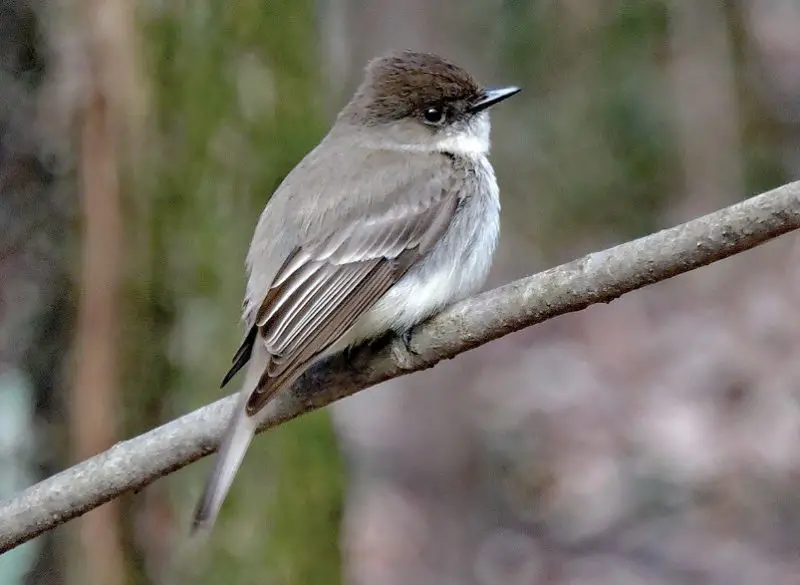
The Eastern Phoebe is a small insect-eating bird with soft gray-brown upperparts and a clean white belly. It is known for its characteristic tail-wagging behavior, often seen bobbing its tail while perched. Adults measure about 5.5 to 6.7 inches in length.
This species is common in Mississippi during spring and summer, when it builds nests under eaves, bridges, or other human-made structures, frequently returning to the same site year after year. Eastern Phoebes catch flying insects by darting out from perches and are often seen near water or open woodlands.
Their song is a sharp “fee-bee” call repeated several times, making them easy to identify in the field. Eastern Phoebes adapt well to suburban and rural environments, and their presence signals the arrival of warmer months in the region.
Blue-headed Vireo
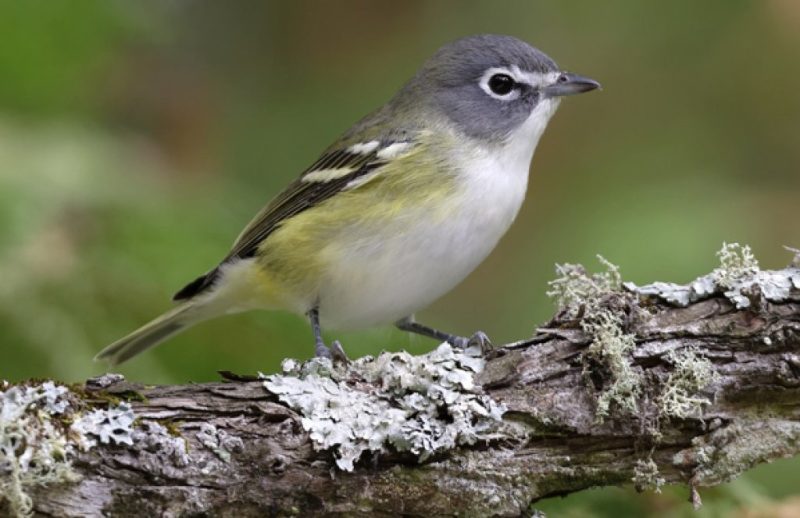
The Blue-headed Vireo is a small songbird characterized by its pale blue-gray head, bright white eye ring, and olive-green back. It measures about 4.7 to 5.5 inches long and has a slender bill suited for insect hunting.
This vireo prefers mixed forests and is often observed during migration seasons in Mississippi. Its slow, melodic song is a series of clear, liquid notes, making it relatively easy to detect despite its quiet and somewhat secretive nature.
Blue-headed Vireos forage methodically through tree branches, gleaning insects and spiders from leaves and bark. They are typically found in wooded areas with dense foliage during their passage through the state, adding a subtle but beautiful note to Mississippi’s birdlife.
FAQ: Small Birds in Mississippi
What are some common small birds found in Mississippi?
Common small birds in Mississippi include the Carolina Chickadee, Tufted Titmouse, Carolina Wren, House Wren, and Eastern Bluebird. These species are often seen in yards, parks, and woodlands throughout the state.
When is the best time to see small birds in Mississippi?
Small birds can be seen year-round in Mississippi, but spring and fall migrations bring the greatest diversity. Winter months also attract some species that visit feeders regularly.
Where do small birds in Mississippi typically live?
Small birds in Mississippi inhabit a variety of habitats such as forests, wetlands, suburban gardens, and grasslands. Many species prefer areas with plenty of shrubs, trees, and access to water.
What do small birds in Mississippi eat?
Most small birds eat insects, seeds, and berries. Backyard feeders offering sunflower seeds, suet, and mealworms attract many of these birds, especially during colder months when natural food is scarce.
How can I attract more small birds to my yard in Mississippi?
To attract small birds, provide fresh water, native plants for shelter and food, and bird feeders stocked with seeds or suet. Avoid using pesticides to ensure a healthy insect supply for insectivorous birds.
Are there any endangered small bird species in Mississippi?
While most small birds in Mississippi are common and widespread, habitat loss and environmental changes can impact some species. Conservation efforts focus on protecting wetlands and forests that support diverse bird populations.


